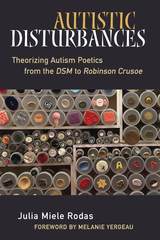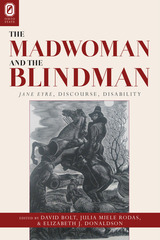2 books by Rodas, Julia Miele

Autistic Disturbances
Theorizing Autism Poetics from the DSM to Robinson Crusoe
Julia Miele Rodas
University of Michigan Press, 2018
While research on autism has sometimes focused on special talents or abilities, autism is typically characterized as impoverished or defective when it comes to language. Autistic Disturbances reveals the ways interpreters have failed to register the real creative valence of autistic language and offers a theoretical framework for understanding the distinctive aesthetics of autistic rhetoric and semiotics. Reinterpreting characteristic autistic verbal practices such as repetition in the context of a more widely respected literary canon, Julia Miele Rodas argues that autistic language is actually an essential part of mainstream literary aesthetics, visible in poetry by Walt Whitman and Gertrude Stein, in novels by Charlotte Brontë and Daniel Defoe, in life writing by Andy Warhol, and even in writing by figures from popular culture.
Autistic Disturbances pursues these resonances and explores the tensions of language and culture that lead to the classification of some verbal expression as disordered while other, similar expression enjoys prized status as literature. It identifies the most characteristic patterns of autistic expression-repetition, monologue, ejaculation, verbal ordering or list-making, and neologism-and adopts new language to describe and reimagine these categories in aesthetically productive terms. In so doing, the book seeks to redress the place of verbal autistic language, to argue for the value and complexity of autistic ways of speaking, and to invite recognition of an obscured tradition of literary autism at the very center of Anglo-American text culture.
Autistic Disturbances pursues these resonances and explores the tensions of language and culture that lead to the classification of some verbal expression as disordered while other, similar expression enjoys prized status as literature. It identifies the most characteristic patterns of autistic expression-repetition, monologue, ejaculation, verbal ordering or list-making, and neologism-and adopts new language to describe and reimagine these categories in aesthetically productive terms. In so doing, the book seeks to redress the place of verbal autistic language, to argue for the value and complexity of autistic ways of speaking, and to invite recognition of an obscured tradition of literary autism at the very center of Anglo-American text culture.
[more]

The Madwoman and the Blindman
Jane Eyre, Discourse, Disability
David Bolt
The Ohio State University Press, 2012
This breakthrough volume of critical essays on Jane Eyre from a disability perspective provides fresh insight into Charlotte Brontë’s classic novel from a vantage point that is of growing academic and cultural importance. Contributors include many of the preeminent disability scholars publishing today, including a foreword by Lennard J. Davis.
Though an indisputable classic and a landmark text for critical voices from feminism to Marxism to postcolonialism, until now, Jane Eyre has never yet been fully explored from a disability perspective. Customarily, impairment in the novel has been read unproblematically as loss, an undesired deviance from a condition of regularity vital to stable closure of the marriage plot. In fact, the most visible aspects of disability in the novel have traditionally been understood in rather rudimentary symbolic terms—the blindness of Rochester and the “madness” of Bertha apparently standing in for other aspects of identity. The Madwoman and the Blindman: Jane Eyre, Discourse, Disability, resists this traditional reading of disability in the novel. Informed by a variety of perspectives—cultural studies, linguistics, and gender and film studies—the essays in this collection suggest surprising new interpretations, parsing the trope of the Blindman, investigating the embodiment of mental illness, and proposing an autistic identity for Jane Eyre. As the first volume of criticism dedicated to analyzing and theorizing the role of disability in a single literary text, The Madwoman and the Blindman is a model for how disability studies can open new conversation and critical thought within the literary canon.
[more]
READERS
Browse our collection.
PUBLISHERS
See BiblioVault's publisher services.
STUDENT SERVICES
Files for college accessibility offices.
UChicago Accessibility Resources
home | accessibility | search | about | contact us
BiblioVault ® 2001 - 2024
The University of Chicago Press









